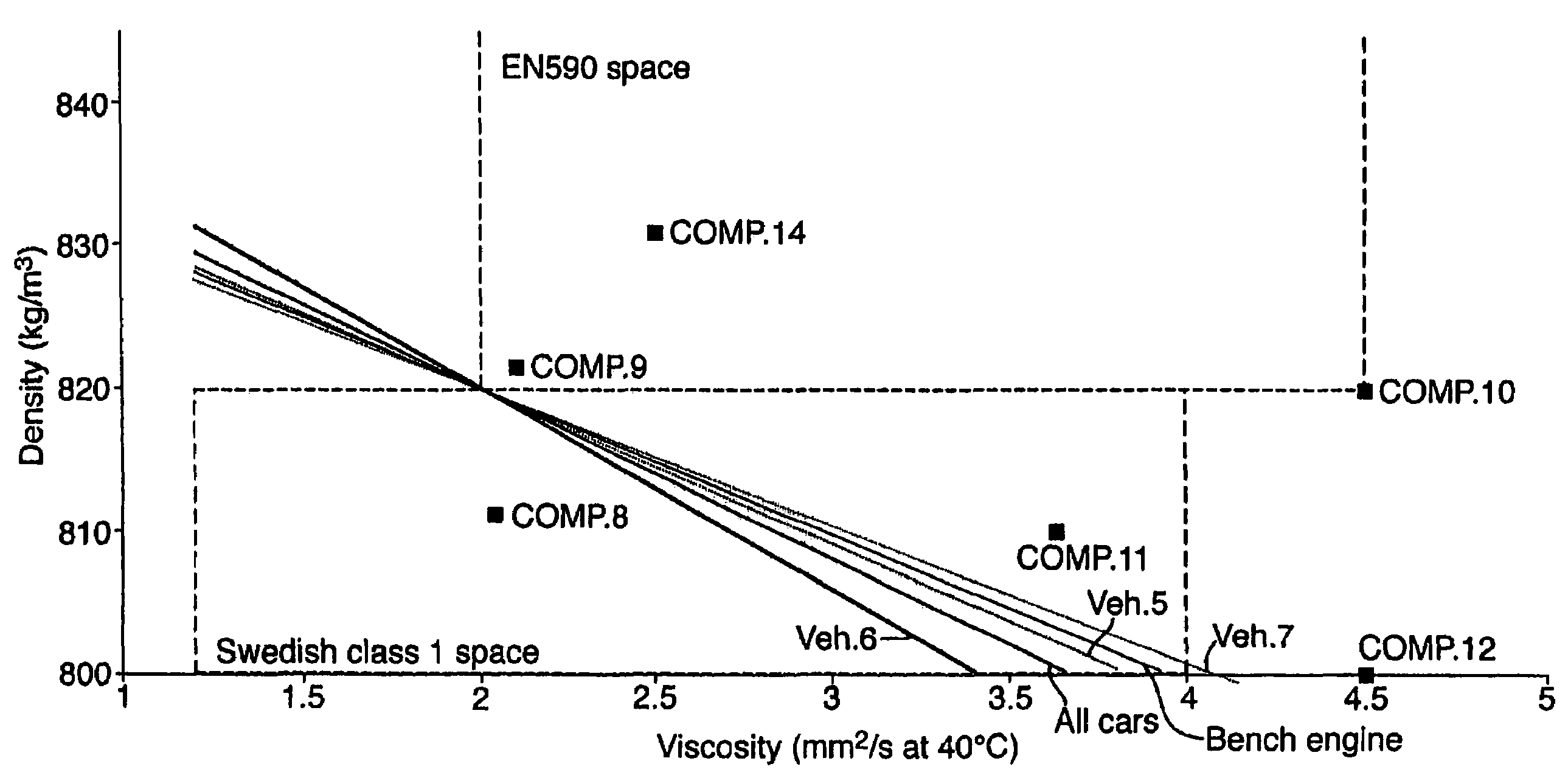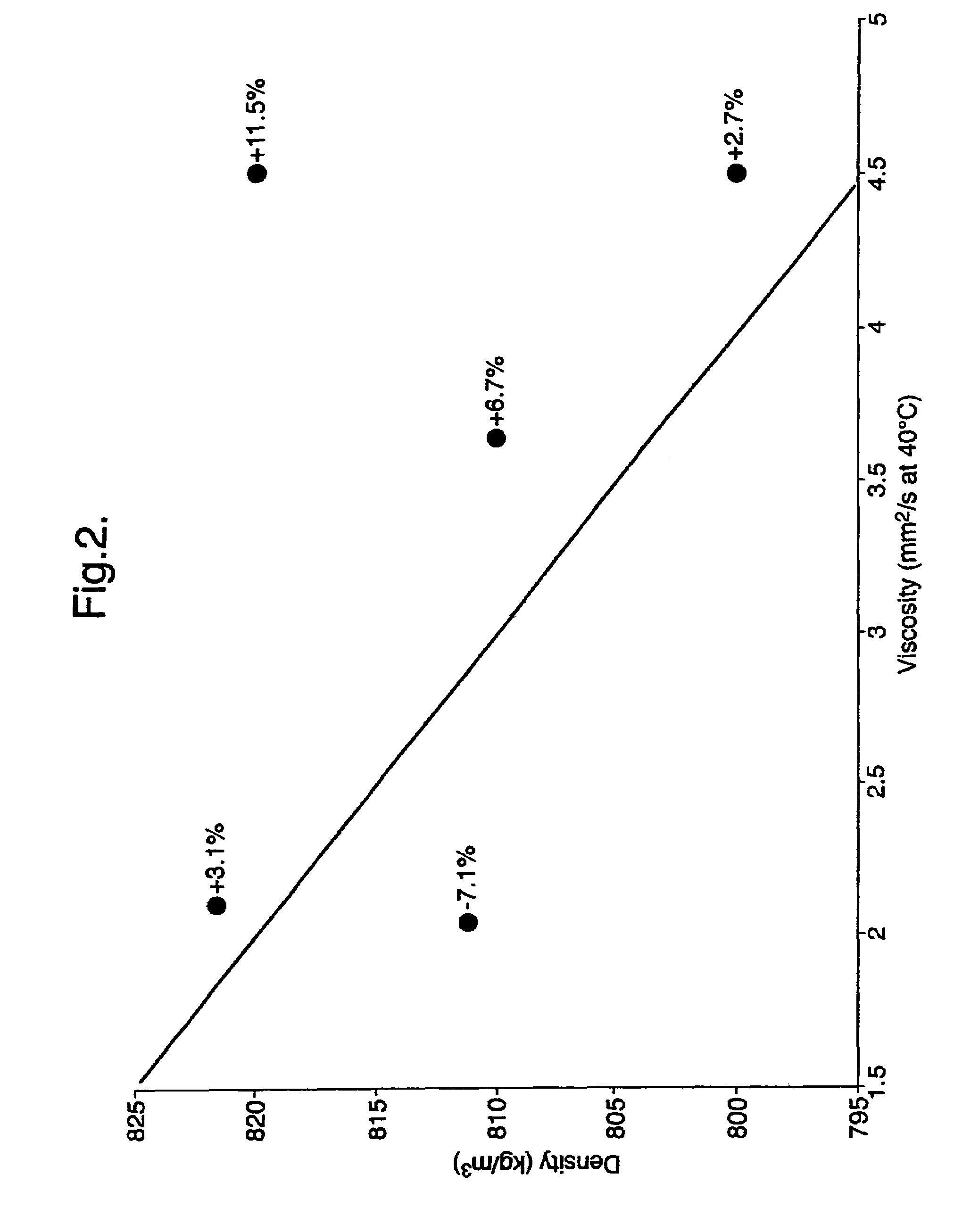Power increase and increase in acceleration performance of diesel fuel compositions
a technology of diesel fuel and acceleration performance, which is applied in the direction of lubricant composition, fuel, liquid carbonaceous fuel, etc., can solve the problems of increasing density, increasing black smoke and hydrocarbon emissions, and reducing air/fuel ratio, etc., and it is not possible from available data to decoupl
- Summary
- Abstract
- Description
- Claims
- Application Information
AI Technical Summary
Benefits of technology
Problems solved by technology
Method used
Image
Examples
example 1
Test Fuels
[0130]The fuels used in the tests were a selection of five fuels, four of which, F1, F2, F4 and F5 lie close to the maxima and minima of the European Standard EN590 specification having ranges of 820-845 kg / m3 for density and 2.0-4.5 mm2 / s at 40° C. for viscosity, with an additional fuel F3 at the centre of the range. The properties of fuels F1-F5 are shown in Table 1:
[0131]
TABLE 1F1F2F3F4F5Density @ 15° C.841821836844829(IP365 / ASTM)D4502), kg / m3Distillation (IP123 / ASTM D86)IBP / ° C.162191157164156T50 / ° C.253243286300338T90 / ° C.321294385386390FBP / ° C.367319403404405Cetane number52.857.255.551.058.0(ASTM D613)Cetane Index49.651.055.755.564.8(IP364 / 84 / ASTMD976)Kinematic2.42.13.254.254.45viscosity @40° C. (IP71 / ASTMD445), mm2 / sSulphur (ASTM2971031137068D2622), mg / kgAromatic21.721.517.517.47.8content (IP391Mod), % m
Test Compositions
[0132]In the following tests, compositions 1, 2, 4, 6 and 7 comprised Fuels F1 to F5 above and compositions 3 and 5 comprised Fuels F2 (minimum dens...
example 2
Test Fuels
[0178]The fuels used in the tests were a Swedish Class I fuel SC1, and an existing high density low viscosity gasoil fuel D1 including cetane improver EHN to bring this value closer to SC1, and compositions containing varying proportions of an ultra low sulphur diesel (ULSD) fuel F6 and a Fischer-Tropsch (GtL) derived component F7 and mineral oil Ondina OD. A comparative fuel, Composition 14, used in some tests was a standard ULSD. The properties of fuels F6, F7, oil OD and diesel fuels SC1 and D1 are shown in Table 10:
[0179]
TABLE 10SC1D1F6F7OD14Density @ 15° C.811.2821.6850.3785.2849.0830.3(IP365 / ASTM)D4502), kg / m3Distillation (IP123 / ASTM D86)IBP / ° C.188.8189.0201.0211.5316.0156.5T50 / ° C.235.8242.5290.0298.0363.5267.0T90 / ° C.270.3291.5337.5339.0387.5319.0FBP / ° C.290.3319.0363.5354.5400.0344.0Cetane number58.65851.1>74.862.253.5(ASTM D613)Cetane Index52.951.577.259.453.0(IP364 / 84 / ASTMD976)Kinematic2.0412.1003.6893.60615.2602.5viscosity @40° C.(IP71 / ASTMD445), mm2 / sSulphur ...
PUM
| Property | Measurement | Unit |
|---|---|---|
| fuel density | aaaaa | aaaaa |
| density | aaaaa | aaaaa |
| kinematic viscosity | aaaaa | aaaaa |
Abstract
Description
Claims
Application Information
 Login to View More
Login to View More - R&D
- Intellectual Property
- Life Sciences
- Materials
- Tech Scout
- Unparalleled Data Quality
- Higher Quality Content
- 60% Fewer Hallucinations
Browse by: Latest US Patents, China's latest patents, Technical Efficacy Thesaurus, Application Domain, Technology Topic, Popular Technical Reports.
© 2025 PatSnap. All rights reserved.Legal|Privacy policy|Modern Slavery Act Transparency Statement|Sitemap|About US| Contact US: help@patsnap.com



